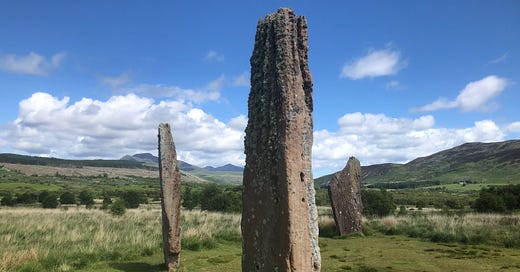Introduction to Earth's Energy Vortexes
How to relate Earth's energies to sacred geometry, physics and DNA.
We must have heard of Earth’s energy vortexes, energetic spots on the land holding higher frequencies, where energy spirals and flows down like a faucet. They are entry and exit points where ley lines (meridians; telluric and cosmic energies) crossed each other. When we immerse ourselves in those energy fields, we will find that our physical body’s electromagnetic field will adjust to the Earth’s frequency where it is located.
In those particular energy vortexes, energies are amplified on many levels: physical, mental, emotional or spiritual. They are like regulators of Earth’s electromagnetic field stabilizing the entire planetary grid system. It has primary energy points, where the energy flow is stronger than at other points, which can be categorized as secondary, tertiary, etc.
Earth acts as a crystalline grid, similar to a giant quartz crystal. It is well known that the primary energy points are the intersection points of the vertices of the Platonic solids (tetrahedron, octahedron, cube, icosahedron and dodecahedron). Here comes Science behind it, or sacred geometry.
When the tetrahedron is inscribed inside a sphere, and we position its apex at the North Pole, the circle joining the three other vertices forming its base is exactly 19.47 degrees south, roughly 19 degrees and 28 minutes south of the equator. This can be applied to the tetrahedron downward, where the circle of latitude 19.47°N meets its three vertices, forming the triangular base. The 19.47°N latitude circle passes near some of the Earth’s most notable volcanic hotspots, especially Hawaii and Mexico’s volcanic belt. The 19.47°S latitude crosses parts of the Andes volcanic region, one of the most active in South America.
I have worked on Google Earth to map out these tetrahedra with the circles of 19.47°N and 19.47°S latitudes. A reference point was needed to fix the initial orientation. I have wisely chosen the prime meridian as the longitude passing through the Great Pyramid of Giza, for the Giza meridian (longitude 31.1342° E) has been proposed by many researchers as a more natural prime meridian for planetary energy models and sacred geometry.
I’ve visited numerous standing stones across the UK, including some fascinating Neolithic sites, and I can say with certainty that many of these ancient structures are positioned precisely on powerful energy points. It suggests there was once a lost knowledge, an understanding of the Earth's energy pathways and nodal points, that guided their placement.
Below is a short introduction to sacred geometry and its practical application using Google Earth. The six intersection points formed by the dual tetrahedron aligned to the Great Pyramid’s meridian at 31.1342°E lie along the energetically significant latitudes of ±19.47°, a band often associated with planetary upwelling and sacred geometry. These points fall near key regions around the world, including the ancient Nubian-Egyptian border, the Great Zimbabwe ruins, Teotihuacan in Mexico, the Coral Sea near the Great Barrier Reef, and remote oceanic zones near Madagascar and Micronesia. Their geometric distribution reveals a possible global pattern of energetically charged nodal points. This suggests that ancient cultures may have consciously aligned sacred sites with these natural harmonics in Earth’s geometry.
Below is the link to download the KML file to be uploaded to Google Earth. Have fun!
Google Earth Application of the Project: Dual Tetrahedron with 19.47° Circles - Giza Meridian





Fascinating, it resonates deeply with some of the themes I explored in my earlier book chapters on geomancy and the sacred sites I've dowsed over the years and current articles.
I had the chance to meet Nassim Haramein at a talk in California back in 2010, and his Holofractographic Universe model seems particularly relevant here. In his framework, tetrahedral geometry and the concept of vector equilibrium suggest that celestial bodies like Earth may exhibit energy dynamics rooted in tetrahedral structures, most notably at the 19.47° latitude, a point often associated with planetary vortex activity.
Similarly, Buckminster Fuller regarded the tetrahedron as the most fundamental unit of space, intrinsic to the structural logic of nature itself. When I observe fractals appearing throughout nature, especially in three-dimensional forms, I can't help but see a correlation with these geometric archetypes, in 3D expression we can find tetrahedrons in 3 dimensional fractals, the Flower of Life etc and other sacred geometries.
The work of Susan Joy Rennison, Carl Munck, and Bruce Cathie also delves into these interconnected ideas, each offering a unique lens on the energetic and geometric nature of Earth and the cosmos.